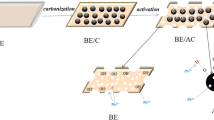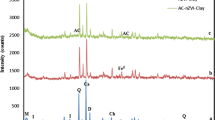Abstract
Nickel aluminum hydrotalcite/clay/activated carbon (LDH/BE/AC) composites were prepared by urea hydrolysis from spent bleaching earth (SBE) to adsorb and remove Chlorotetracycline (CTC), Tetracycline (TC) and Ciprofloxacin (CIP) in aqueous solution. The adsorption method has the advantages of low cost, high efficiency, no secondary pollution and simple and easy operation. A series of performance tests were carried out on the composites. The results show that when the dosage of clay/activated carbon (BE/AC) is 0.2 g, the distribution of LDH/BE/AC on BE/AC is relatively uniform, which is conducive to the adsorption of pollutants. Compared with BE/AC, because the synthesis of LDH/BE/AC occupies the pores on the surface and inside of BE/AC, the specific surface area and pore volume of LDH/BE/AC composites are reduced. But at the same time, the adsorption sites of BE/AC are increased and the adsorption capacity is enhanced. The optimum adsorption capacities of the composites for CTC, TC and CIP are 160.4 mg/g, 122.3 mg/g and 91.3 mg/g respectively, and have good cycle stability. This paper provides an idea for industrial sewage treatment, that is treating waste with waste.










Similar content being viewed by others
Data availability
All data included in this study are available upon request by contact with the corresponding author.
References
D. Xu et al., Application of biochar derived from pyrolysis of waste fiberboard on tetracycline adsorption in aqueous solution. Front. Chem. 7, 943 (2019)
C. Corroto et al., Constructed wetlands as an alternative for arsenic removal from reverse osmosis effluent. Sci. Total Environ. 691, 1242–1250 (2019)
P. Roy Choudhury et al., High pressure ultrafiltration CuO/hydroxyethyl cellulose composite ceramic membrane for separation of Cr (VI) and Pb (II) from contaminated water. Chem. Eng. J. 336, 570–578 (2018)
D. Wang et al., Simultaneously efficient adsorption and photocatalytic degradation of tetracycline by Fe-based MOFs. J. Colloid Interface Sci. 519, 273–284 (2018)
J. Wang, S. Wang, Activation of persulfate (PS) and peroxymonosulfate (PMS) and application for the degradation of emerging contaminants. Chem. Eng. J. 334, 1502–1517 (2018)
Y. Yang et al., The synthesis of h-BN-modified Z-scheme WO3/g-C3N4 heterojunctions for enhancing visible light photocatalytic degradation of tetracycline pollutants. ACS Omega 7(7), 6035–6045 (2022)
W. Zhu et al., Renewable molybdate complexes encapsulated in anion exchange resin for selective and durable removal of phosphate. Chin. Chem. Lett. 32(11), 3382–3386 (2021)
H. Pang et al., Recent advances in composites of graphene and layered double hydroxides for water remediation: a review. Chem. Asian J. 14(15), 2542–2552 (2019)
A. Li et al., Fabrication and characterization of novel ZnAl-layered double hydroxide for the superadsorption of organic contaminants from wastewater. ACS Omega 5(25), 15152–15161 (2020)
Y. Chen et al., Synergistic adsorption and advanced oxidation activated by persulfate for degradation of tetracycline hydrochloride using iron-modified spent bleaching earth carbon. Environ. Sci. Pollut. Res. Int. 29(17), 24704–24715 (2022)
D. Wan et al., Enhanced adsorption of aqueous tetracycline hydrochloride on renewable porous clay-carbon adsorbent derived from spent bleaching earth via pyrolysis. Langmuir 35(11), 3925–3936 (2019)
H.-H. Zhao et al., Thermal oxidative degradation and ageing performance of silicone rubber filled with attapulgite. Chin. J. Chem. Phys. 34(3), 309–322 (2021)
F. Liu et al., Oxygen-vacancy-Rich NiMnZn-layered Double hydroxide nanosheets married with Mo2CTx MXene for high-efficiency all-solid-state hybrid supercapacitors. ACS Appl. Energy Mater. 5(3), 3346–3358 (2022)
F. Qin et al., Electrocatalytic performance of Fe–N encapsulated in hollowly mesoporous carbon microspheres for oxygen reduction reaction and Zn–Air battery. ACS Sustain. Chem. Eng. 10(21), 7031–7040 (2022)
W. Wu et al., Synthesis, characterization, and high-temperature HCl capture capacity of different proportions of potassium fluoride-doped CaMgAl layered double hydroxides. ACS Omega 4(19), 18159–18166 (2019)
H.M. Ali et al., Kinetics and mechanism studies of oxidation of dibromothymolsulfonphthalein toxic dye by potassium permanganate in neutral media with the synthesis of 2-bromo-6-isopropyl-3-methyl-cyclohexa-2,5-dienone. ACS Omega 7(18), 16109–16115 (2022)
W. Osada et al., Adsorption, desorption, and decomposition of formic acid on Cu(977): The importance of facet of the step. J. Phys. Chem. C 126(19), 8354–8363 (2022)
R. Shao et al., A facile and versatile strategy towards high-performance Si anodes for Li-ion capacitors: concomitant conductive network construction and dual-interfacial engineering. Nano Energy (2019). https://doi.org/10.1016/j.nanoen.2019.06.020
Q. Zhu, B. Wang, T. Tan, Conversion of ethanol and acetaldehyde to butadiene over MgO–SiO2 Catalysts: effect of reaction parameters and interaction between MgO and SiO2 on catalytic performance. ACS Sustain. Chem. Eng. 5(1), 722–733 (2016)
K.M. Parida, L. Mohapatra, Carbonate intercalated Zn/Fe layered double hydroxide: a novel photocatalyst for the enhanced photo degradation of azo dyes. Chem. Eng. J. 179, 131–139 (2012)
S. Nayak, L. Mohapatra, K. Parida, Visible light-driven novel g-C3N4/NiFe-LDH composite photocatalyst with enhanced photocatalytic activity towards water oxidation and reduction reaction. J. Mater. Chem. A 3(36), 18622–18635 (2015)
W. Guerra et al., Synthesis, characterization, and antibacterial activity of three palladium(II) complexes of tetracyclines. J. Inorg. Biochem. 99(12), 2348–2354 (2005)
Q. Yao et al., 3D assembly based on 2D structure of cellulose nanofibril/graphene oxide hybrid aerogel for adsorptive removal of antibiotics in water. Sci Rep 7, 45914 (2017)
J. Imanipoor, M. Mohammadi, Porous aluminum-based metal-organic framework-aminoclay nanocomposite: sustainable synthesis and ultrahigh sorption of cephalosporin antibiotics. Langmuir 38(18), 5900–5914 (2022)
Q. Yang et al., Breathing transition induced removal of nitro-benzenediol from aqueous solution via magnetic MIL-53(Al) composites. Cryst. Growth Des. 22(6), 3905–3913 (2022)
B. Li et al., Efficient toluene adsorption on metal salt-activated porous carbons derived from low-cost biomass: a discussion of mechanism. ACS Omega 5(22), 13196–13206 (2020)
R. Wang et al., Molecular dynamics beyond the monolayer adsorption as derived from langmuir curve fitting. Inorg. Chem. 61(20), 7804–7812 (2022)
F.M. Mtunzi et al., Mesoporous SBA-15 functionalized with G-5 Poly(amidoamine): a sustainable adsorbent for effective sequestration of an emerging aqueous contaminant. ACS Appl. Nano Mater. 4(3), 3052–3061 (2021)
I.M. Kenawy et al., Preparation of lactic acid modified cellulose nanoparticles by microwave heating for preconcentration of copper from blood and food samples. Environ. Sci. Pollut. Res. Int. 27(7), 7256–7266 (2020)
J. Zhang et al., Kinetics, equilibrium and thermodynamics of the sorption of p-nitrophenol on two variable charge soils of Southern China. Appl. Surf. Sci. 298, 95–101 (2014)
Y. Wang et al., Preparation of Fe/Ni bimetallic oxide porous graphene composite materials for efficient adsorption and removal of sulfonamides. Langmuir 37(41), 12242–12253 (2021)
S. Shi et al., Facile low temperature hydrothermal synthesis of magnetic mesoporous carbon nanocomposite for adsorption removal of ciprofloxacin antibiotics. Ind. Eng. Chem. Res. 52(7), 2604–2612 (2013)
C. Yang et al., In situ nano-assembly of Mg/Al LDH embedded on phosphorylated cellulose microspheres for tetracycline hydrochloride removal. Cellulose 28(1), 301–316 (2020)
X. Liu et al., Removal of amoxicillin from water by concrete-based hydrotalcites: efficiency and mechanism. Process Saf. Environ. Prot. 163, 210–217 (2022)
Z. Qiu et al., Regenerable Mg/Fe bimetallic hydroxide for remarkable removal of low-concentration norfloxacin from aqueous solution. Colloids Surf. A: Physicochem. Eng. Asp. 644, 1218825 (2022)
A. Elhaci et al., MgAl-Layered double hydroxide for amoxicillin removal from aqueous media. Int. J. Environ. Anal. Chem. 101(15), 2876–2898 (2020)
J. Tang et al., One-step synthesis of magnetic attapulgite/carbon supported NiFe-LDHs by hydrothermal process of spent bleaching earth for pollutants removal. J. Clean. Prod. 172, 673–685 (2018)
C. Li et al., Layered double hydroxide-based nanomaterials as highly efficient catalysts and adsorbents. Small 10(22), 4469–4486 (2014)
X. Dao et al., Surface complexation enhanced adsorption of tetracycline by ALK-MXene. Ind. Eng. Chem. Res. 61(17), 6028–6036 (2022)
H.I. Inyang, A. Onwawoma, S. Bae, The Elovich equation as a predictor of lead and cadmium sorption rates on contaminant barrier minerals. Soil Tillage Res. 155, 124–132 (2016)
Acknowledgements
This study was funded by the Jiangsu Higher Institutions Key Basic Research Projects of Natural Science (18KJA430003), Independent Research Project of Key Laboratory of Green Catalytic Materials and Technology of Jiangsu Province in 2018 (ZZZD201803) and Natural Science Research Plan of Huai'an in 2019 (HAB201952).
Funding
This study was funded by the Jiangsu Higher Institutions Key Basic Research Projects of Natural Science (Grand No. 18KJA430003), Independent Research Project of Key Laboratory of Green Catalytic Materials and Technology of Jiangsu Province in 2018 (Grand No. ZZZD201803) and Natural Science Research Plan of Huai'an in 2019 (Grand No. HAB201952).
Author information
Authors and Affiliations
Contributions
WL: designed the experiments and discussed the results. JS: carried out the experiments, analysis, as well as prepared the manuscript. XL: helped with sample preparation. KY, SZ, CY, and XL: gave technical support.
Corresponding author
Ethics declarations
Conflict of interest
The authors declare that they have no conflict of interest.
Informed consent
All authors of this article have given informed consent.
Research involving human and animal participants
This article does not contain any studies with human participants or animals performed by any of the authors.
Additional information
Publisher's Note
Springer Nature remains neutral with regard to jurisdictional claims in published maps and institutional affiliations.
Rights and permissions
Springer Nature or its licensor (e.g. a society or other partner) holds exclusive rights to this article under a publishing agreement with the author(s) or other rightsholder(s); author self-archiving of the accepted manuscript version of this article is solely governed by the terms of such publishing agreement and applicable law.
About this article
Cite this article
Liu, W., Sun, J., Li, X. et al. Preparation of Ni Al hydrotalcite/clay/activated carbon and its adsorption of antibiotics in aqueous solution. J Mater Sci: Mater Electron 33, 26892–26904 (2022). https://doi.org/10.1007/s10854-022-09354-8
Received:
Accepted:
Published:
Issue Date:
DOI: https://doi.org/10.1007/s10854-022-09354-8




